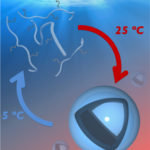2020/5/5 スタンフォード大学

・ スタンフォード大学が、道路を走行中の EV のワイヤレス給電の実現に向けた技術を実証。
・ 既に利用されているスマートフォンのワイヤレス充電パッドでは、充電時にデバイスを動かさずに配置する必要がある。EV の充電の場合でも、充電ステーションで 1~2 時間をかけるプラグインによる現在の給電手段は利便性に欠ける。
・ 同大学では 3 年前に、動く物体をワイヤレスで給電する技術を初めて開発したが、研究室外での効率性が課題であった。今回実証の技術は、道路を走行する EV 給電へのスケールアップの可能性を示唆するもの。
・ ワイヤレスチャージャーでは、受電側のデバイスの磁気コイルが共振する周波数で振動する磁場を作ることで給電する。同技術の課題は、給電側と受電側の間の距離が少しでも変わると共振周波数が変わってしまうこと。
・ 3 年前の技術では、チャージャーと動く物体の間の距離が変わるとシステムに動作周波数を自動調整させる、増幅器とフィードバックレジスタを取り入れることでこの課題に対処したが、実用に適う効率性が得られなかった。増幅器の機能に相当な電力を消費するため、システム中の電力の 10%のみの送電に止まった。
・ 今回、増幅器をより効率的な「スイッチ・モード」増幅器に代えることで、同システムのワイヤレス送電効率を 92%に引き上げることに成功。同増幅器は新しいものではないが、高効率の増幅機能には特定の条件を要するため、その改善や追加的な理論的研究に数年をかけ、作動できる回路構成を設計した。
・ 今回開発した実験用プロトタイプでは、2~3 フィート(約 61~91cm)の距離で 10W をワイヤレス給電する。EV で必要となる 10~100kW を給電するシステムへのスケールアップを阻む基本的な障壁は無く、時速約 113km で走行中の EV が 1.2m の充電ゾーンを横切るのにかかる僅か数ミリ秒という充分な速度で走行中の EV に給電できる。EV のバッテリーの電力貯蔵速度が唯一の制限要因。
・ 強力な給電システムであるが、発生する磁場は安全指針の範囲内であり、健康に対するリスクを引き起こす恐れはないと考える。
・ 同ワイヤレスチャージャーの高速道路への埋め込みの実現にはさらに時間を要するが、床や屋根への導入にかかるコストは低いため、ロボットやドローンでの利用は間もなく実現可能と考える。
・ 本研究は、米国国防総省(DoD)の Vannevar Bush Faculty Fellowship が支援した。
URL: https://engineering.stanford.edu/magazine/article/how-we-might-recharge-electric-car-itdrives
<NEDO海外技術情報より>
(関連情報)
Nature Electronics 掲載論文(アブストラクトのみ:全文は有料)
Robust and efficient wireless power transfer using a switch-mode implementation of a nonlinear
parity–time symmetric circuit
URL: https://www.nature.com/articles/s41928-020-0399-7
Abstract
Stationary wireless power transfer has been deployed commercially and can be used to charge a variety of devices, including mobile phones and parked electric vehicles. However, wireless power transfer set-ups typically suffer from an inherent sensitivity to the relative movement of the device with respect to the power source. Nonlinear parity–time symmetric circuits could be used to deliver robust wireless power transfer even while a device is moving rapidly, but previous implementations have relied on an inefficient gain element based on an operation-amplifier circuit, which has inherent loss, and hence have exhibited poor total system efficiency. Here we show that robust and efficient wireless power transfer can be achieved by using a power-efficient switch-mode amplifier with current-sensing feedback in a parity–time symmetric circuit. In this circuit, the parity–time symmetry guarantees that the effective load impedance on the switch-mode amplifier remains constant, and hence the amplifier maintains high efficiency despite variation of the transfer distance. We experimentally demonstrate a nonlinear parity–time symmetric radiofrequency circuit that can wirelessly transfer around 10 W of power to a moving device with a nearly constant total efficiency of 92% and over a distance from 0 to 65 cm.



